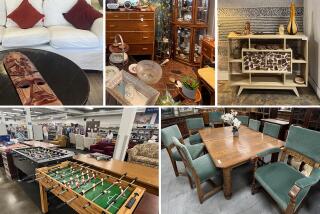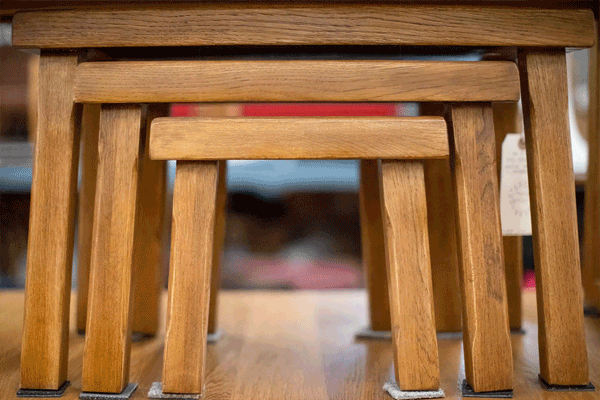CONSUMERS : Bargains Lurk Among Used Electronic Items
- Share via
If you don’t have to have the latest electronics--stereos, tape decks, VCRs, CD players or turntables--there are bargains to be found on used and reconditioned equipment. You can find suitable older models taken as trade-ins at electronics stores, offered by private sellers in classified advertisements or sold at swap meets and flea markets nationwide.
But, generally, “the market for used TVs, VCRs and stereo equipment has dropped off because pricing of new equipment is so inexpensive today,” observed Mark Rosenker of the Electronic Industries Assn., a Washington-based trade group of American electronics manufacturers.
“The prices are very competitive, too,” he added, explaining that a good, new videocassette recorder can be purchased for less than $200 or a 20-inch television set with remote for $239-$249.
“And none of it breaks,” he said. “The average life of a TV is 12 to 14 years. I’ve got one that’s 20 years old. I just move it from room to room. . . . If I were going to get rid of it, I wouldn’t sell it. I’d just give it away to the Salvation Army or to some kid who needed one.”
Eric Schuster, manager of Rogersound Labs in Santa Monica, agreed the market for secondhand electronics goods is soft but added: “Electronics are changing so fast that within a year the thing you bought is almost outdated. We almost never take anything in trade any more. If we do, we would feel obligated to have a warranty of 90 days on it.
“The people who come in here want the latest, the biggest, best, brightest and sharpest TV or whatever,” he said. “And all the new things have full warranties on them. But if they’re looking for used items, probably the best place to get used equipment is through (classified ads from) private parties.”
Ted Shannon Henry, an owner of Henry Radio in West Los Angeles, observed that, “there’s a lot of action in used ham-radio equipment but almost none in video. Nobody wants a used TV. In audio, it’s mostly amps (amplifiers).”
Some stores taking trade-ins sell the equipment “as is” after ensuring it works; others have technicians check it, replace bad parts, then sell it with a 90-day warranty.
Henry Radio has started taking used equipment on consignment for customers, said Jerry Sharp, who runs the stereo department and who observed “we find (the process) more advantageous. . . . That way our money isn’t tied up in the equipment, as it would be on a trade-in. We sell it for the customer; he gets 75% and we get 25% commission for selling it.”
He displayed a consignment Bang & Olufsen turntable. “In 1985, I sold it to a guy from Lake Elsinore. He paid close to $1,000 for it. It is one of the first turntables with a straight-line tracking arm. We’re selling it for $257 now; the customer will get 75% of that. That’s better than he would get on a trade-in.”
He also cited the example of a Bang & Olufsen 2400 receiver. It cost $550 new in 1983 but now sells for $78 on consignment; it would be worth $30 to $40 on trade-in. Henry Radio doesn’t warranty consignment items but does offer an unconditional 10-day return.
Sharp and others knowledgeable about electronics warn would-be buyers to be careful with used speakers, because “they deteriorate mechanically. The foam (inside the speaker cone) disintegrates in smog.”
For consumers selling items, it pays to know their equipment and what it’s worth, the experts added. “Some of it is like having a vintage T-Bird or a Stutz Bearcat, because it’s gone up so much in value,” Sharp said. “A 70-watt Marantz Model 9 power amp with tubes made from 1964-68 was $390 new. Now it’s worth $1,792.” (That was a 1989 quote; the newest expert quote is $8,500.)
Buyers and sellers can check equipment prices in books published by Orion Research Corp., of Durango, Colo. Orion’s listings are the electronic industry equivalent of the Kelley Blue Books for cars; they’re updated and published annually.
Most audio-video stores keep Orion books on hand, as do most pawnshops, said George Grosjean, a stereo salesman for Radio Lab in Glendale. And most of those dealers will allow courteous customers to consult the Orion volumes--seven in all, covering a range of products, including electronic equipment, cameras and personal computers, said Roger Rohrs, Orion books’ publisher. He added that the books are available at public libraries.
Grosjean urged used-equipment buyers to test gear to ensure it works: “Be wary. If you can’t try it out at a swap meet or garage sale, don’t buy it. Even then, you’re taking a chance on how long it will work. A used CD player, for example, is worth only $25. If it’s bad, it costs about $200 to fix it. Even if you plug it in, and test it, and listen to it, it may be all right for awhile. Some may not act up for an hour or two.”
The greatest demand in the used-electronics market seems to be in “the high-end, better stuff,” said Randy Cooley of Santa Monica’s Audio Research, which takes equipment in trade.
“You can get something a few years old for half price or less, depending on the product,” he said. “Somebody just traded in an Audio Research SP8 pre-amp that’s three years old and cost $1,995 new. It will sell for $995.”
When his store takes trade-ins, “we have technicians look at them and make sure they meet the (product) specifications or better, but we don’t warranty them,” Cooley said. But “if something happens to it within a short period of time, we’ll fix it for free because we don’t want the customer to feel bad about buying it.”
And what about that stuff sold at swap meets or flea markets? It’s often equipment that the industry calls “B stock,” repackaged, reconditioned goods returned to a manufacturer by stores because it is faulty or broken. Manufacturers recondition it, add a short warranty and sell it to swap meet dealers, who, in turn, offer it at reduced prices to consumers.
Consumers should switch their new purchases on and off frequently, shortly after purchase, as the equipment then is most likely to fail--early on and while still under the shortened warranty, Rohrs said.
“Probably 99.9% of (electronic) merchandise sold at swap meets is new or factory repacks,” said Detective Mark Myrdahl, who heads the pawnshop-swap meet section of the Los Angeles Police Department burglary-auto theft division.
“I’d say it’s ‘Buyer beware,’ ” Myrdahl added. “If there’s a driver’s license number etched on it, it’s stolen. Or if you see an ad in the paper that implies the item is stolen, don’t buy it. Because if you have knowledge that it’s stolen, and you buy it, that’s a crime.”
To ensure that a used product isn’t “hot,” Myrdahl urged buyers and sellers to go to their local LAPD division and ask the desk officer to check the item’s make, model and serial number through a state computer registry of serial numbers of stolen property.
More to Read
Inside the business of entertainment
The Wide Shot brings you news, analysis and insights on everything from streaming wars to production — and what it all means for the future.
You may occasionally receive promotional content from the Los Angeles Times.










